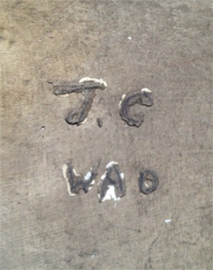
THE BATH WAS an exhibit in the trial of George Joseph Smith for the murder of Alice Smith (née Burnham). It was brought down to London by Inspector William Drabble. In 2013, his great-grandson, Gordon Lonsdale, told the museum staff of the family story that Inspector Drabble had marked the bath with his initials, and, on examination of the object, this proved to be quite correct.
It was a report in the News of the World about the tragic inquest of Margaret Lloyd – a bride who had drowned in her bath in Highgate a week before Christmas 1914 – that prompted a Mr Charles Burnham and a Mrs Crossley to go to the police, and which brought Divisional Detective Inspector Neil to investigate a complicated case of a series of bigamies and murders. Burnham was a Buckingham fruit grower whose 25-year-old daughter, Alice, had married George Smith in Portsmouth in November 1913, despite parental objections. The couple went on holiday to Blackpool where Crossley had been their landlady. Alice had drowned in the bath on 12 December 1913, not long after her wedding in October of that year. The police agreed with Burnham that the two cases were likely to be linked. The probate issues from Margaret Lloyd’s will were being administered by a solicitor and, when the ‘grieving husband’, John Lloyd, attended an appointment to receive money due to him, the police were waiting for him. He admitted that his real name was George Joseph Smith and that he was the same man who had married Alice Burnham.
The year before Alice Burnham’s death in Blackpool, Bessie Munday had died, on 13 July 1912, whilst taking a bath in Herne Bay where she was staying with her husband, Henry Williams, whom she had married in Weymouth in August 1910. ‘Henry Williams’ also transpired to be none other than George Smith. Inquiries showed that Smith had conducted no fewer than seven bigamous marriages between 1908 and 1914. He apparently had a ‘masterful’, ‘hypnotic’ way with some women, a trait that was only exceeded by his ruthlessness in acquiring their money.

Inspector William Drabble marked the bath with his initials
Smith’s complex series of relationships started in January 1898 when, at the age of 26 and using the name of George Love, Smith had married, legally and for the first time, 18-year-old Caroline Thornhill in Leicester. They moved to London and she worked as a maid for a number of employers, stealing from them under her husband’s tuition. Caroline was arrested in Worthing, trying to pawn some silver spoons and she was sent to prison for twelve months. On her release she incriminated her husband, who was then jailed for two years in January 1901. On his release, Caroline fled to Canada. In June 1908, Smith met a widow from Worthing, Florence Wilson, and married her, bigamously, three weeks later. By 3 July he had left her after taking the £30 she had withdrawn from her savings account. On 30 July 1908 he had undertaken a second bigamous marriage, to Edith Pegler in Bristol, who had replied to his advertisement for a housekeeper. The third, in October 1909, was when he married Sarah Freeman, using the name of George Rose. He later married Alice Reid in September 1914, using the name of Charles Oliver James.
When Smith appeared at the Old Bailey, charged with murdering Alice Burnham, Bessie Munday and Margaret Lloyd, Detective Inspector Neil demonstrated to the jury the method of drowning his victims by raising their knees whilst they were in the bath. His assistant, a nurse in a bathing costume, required artificial respiration after the courtroom demonstration and Smith was duly convicted.
Smith’s trial took place during the dark days of the First World War and the judge, Mr Justice Scrutton, remarked that ‘… while this wholesale destruction of human life is going on, for some days all the apparatus of justice in England has been considering whether one man should die …’ The jury returned their guilty verdict in twenty-two minutes, and Smith was executed on Friday, 13 August 1915 at Maidstone prison.
Caroline Thornhill, whom Smith had married legally, was now a widow and she married a Canadian soldier the day after Smith’s execution.
The bath in which Margaret Lloyd died in Highgate was returned to its owner who controversially sold it to Madame Tussauds.
In 2015 the bath from Blackpool was loaned out to the Galleries of Justice in Nottingham as part of their ‘World War 1: Heroes and Villains’ exhibition.